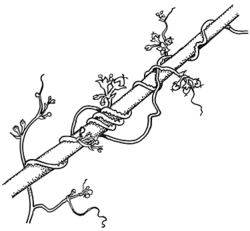
Description: Mainly annual parasites with twining yellow, brown or reddish stems with haustoria.
Leaves reduced to small scales, glabrous.
Flowers 5- or rarely 3- or 4-merous, axillary, in cymose clusters, bracteate. Sepals united at the base [or free]. Corolla tubular or campanulate, distinctly lobed, lacking a mid-petaline band, glabrous. Stamens inserted at the throat between the corolla lobes, subtended by fimbriate scales. Ovary 2-locular with 2 ovules per loculus, glabrous; styles 2, free [or united] with capitate or linear stigmas.
Capsule subglobose or ovoid, circumsciss or indehiscent.
Distribution and occurrence: World: c. 170 species, cosmopolitan. Australia: 10 species (4 species endemic, 6 species naturalized), all States.
Text by R. W. Johnson
Taxon concept:
| | Key to the species | |
| 1 | Stigmas capitate | 2 |
| Stigmas linear | Cuscuta epithymum |
| 2 | Flowers in dense globose clusters, pedicels mainly less than 2.5 mm long | 3 |
| Flowers in loose few-flowered clusters, pedicels 3–6 mm long
Back to 1 | 5 |
| 3 | Styles more or less absent; corolla mainly 3- or 4-lobed | Cuscuta victoriana |
| Styles c. 1 mm long; corolla 5-lobed
Back to 2 | 4 |
| 4 | Corolla lobes obtuse; scales subtending stamens shorter than the corolla tube, with few fimbriae | Cuscuta australis |
| Corolla lobes acute, often inflexed; scales subtending stamens longer than the corolla tube, much fimbriate
Back to 3 | Cuscuta campestris |
| 5 | Calyx as long as corolla tube, corolla lobes obtuse as long as or longer than the tube | Cuscuta tasmanica |
| Calyx shorter than the corolla tube, corolla lobes acute shorter than the tube
Back to 2 | Cuscuta suaveolens |
|


